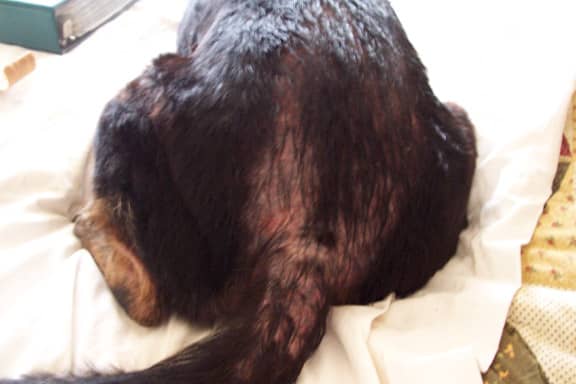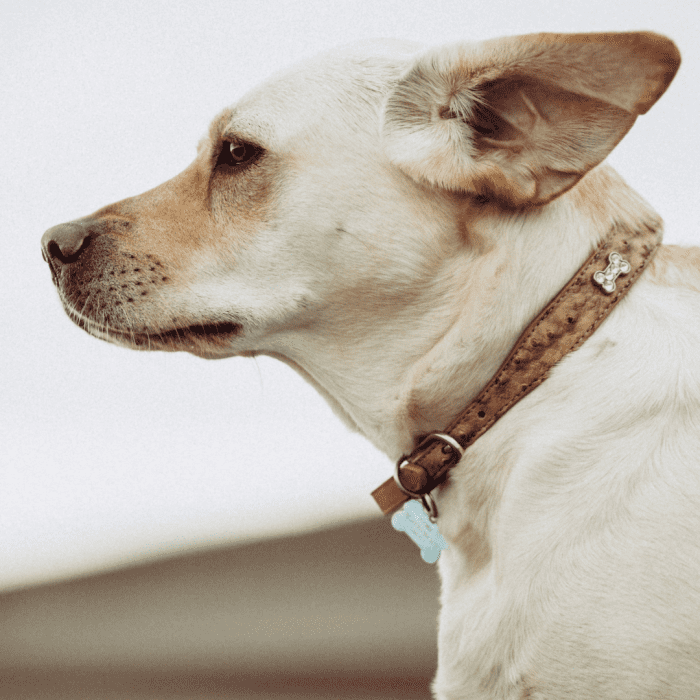Beef and Hot Spots on Dogs
I am a freelance writer, author of 5 books, grant-writer, poet, river rat, amateur astronomer, and nonprofit consultant from Texas.

What's a hot spot on a dog, and what are the causes?
Sharon McCutcheon
Why Do Dogs Get Hotspots?
Sometimes, our doggy family members develop sores or bare, itchy spots on the skin. These are known as hot spots. Labrador Retrievers and dogs of similar size and coloration seem to be prone to developing this skin condition, especially during the warm summer months.
Scratching, Licking, and Chewing
If you notice your dog scratching, licking, or chewing at a spot on his skin obsessively, you should have it looked at immediately. Bare patches in the fur are often the first sign of a hot spot, and they will suddenly appear at the site where the dog has been chewing to relieve the itching. Hot spots can double or triple in size in just a few hours. If left untreated, they can turn into painful sores and hair loss. Untreated, hot spots can become seriously infected. There are several causes for the condition which we will examine in this article.
What Causes Hot Spots?
- Underlying or Secondary Disease
- Environmental and Dietary Allergies
- Mosquitoes, Fleas, and Insect Allergies
- Flea Allergy Dermatitis or FAQ
- Psychology: Is Your Dog Mentally Healthy?

Hot spot on lower back caused by flea dermatitis.
© 2011 photo by Tom King
1. Underlying or Secondary Diseases
If you find that your dog frequently develops hot spots, go see a vet. Your veterinarian will do a full blood workup. One common cause of hot spots is a malfunctioning thyroid gland.
Be sure to always report hot spots to your vet anytime you are in for a checkup. Any unusual symptoms combined with blood test results may suggest an underlying condition requiring treatment.
2. Environmental and Dietary Allergies
Just like people, dogs can develop allergies to food or things in the environment. Dogs can even be sensitive to some ingredients in dog food the way people are sensitive to certain foods like peanuts or gluten.
If you feed a dog the same type or brand of food all of the time, they may become sensitive to some ingredient in the food over time. If you don't change up their food, your dog may develop a more severe allergy to whatever it's sensitive to—something like 15% of canine skin diseases are caused by food allergies.
Dog Food Ingredients That May Cause Allergies
| Eggs | Lamb | Milk |
| Corn | Beef | Soy |
| Fish | Chicken | Wheat |
| Whey | Pork | Preservatives (used in manufacturing) |
Food Allergy Symptoms
- Ear inflammation
- Loss of appetite
- Anal itching
- Face rubbing
- Head shaking
- Hair loss
If you don't treat these symptoms, food allergies can lead to mood changes, asthma, seizures, vomiting, sneezing, asthma, gas, and loose stool. Chemical and environmental irritants like household dust, some types of shampoo, pollen, shampoos, or some of the household chemicals you clean with can also trigger an allergic reaction.
3. Mosquitoes, Fleas, and Insect Allergies
Another common cause of hot spots in dogs is insect bites, in particular, fleas and mosquitoes. Chiggers and other almost invisible insects can also create skin irritation at the site of the bite. Dogs will scratch, lick, and chew on itchy, irritated spots and can pull away fur and break the skin. Insect-related hot spots are due to an extreme insect bite allergy called flea dermatitis.
Secondary Bacterial Infections
If bacteria gets into the open wound, the wound can spread. As the dog licks, scratches, and chews on the spot, it can cause bacteria to infect the wound. The wound can then grow and spread, creating a hot spot.
Scroll to Continue
Read More From Pethelpful
4. Flea Allergy Dermatitis or FAD
FAD is an allergy to the saliva of fleas. It's different from the hot spots caused by flea bites because it doesn't require multiple bites. It only takes one bite to cause a severe reaction in the dog that has been bitten.
FAD causes a reaction characterized by persistent scratching and spots that appear almost overnight. The above picture of my dog, Daisy, shows the most common FAD symptom—a Christmas tree pattern of hair loss on the lower back and at the root of the tail.
These spots can be scaly, rough, and ooze due to the dog frantically scratching and chewing at it. Dogs that have flea allergy dermatitis may only have a few fleas, and even if you treat them regularly, if just one or two get through, your dog may suffer another outbreak which will cause them to do the following:
- scratch
- bite themselves
- chew at their skin
- rub their bodies against rough surfaces
- lick their paws
- pull out tufts of hair
How to Treat Flea Allergy Dermatitis
First, control the fleas. Fleas can live more than a year and are more common in temperate weather with high humidity.
- Treat Your House: You'll need to treat your house for fleas first and then treat your dogs and cats at the same time. You have to do everything you can to make sure no fleas are left untreated.
- Methods: Dipping your dog is probably the best way to clear them. You can spray the house and treat your rugs with borate-based flea powder.
- Treat the Yard: Don't forget to spray the yard, too, especially in moist, shady areas, or piles of decaying material. Treat any spot your dog likes to lie around in.
- Treat Bedding: Stuff his bed with cedar or spray on rosemary oils to repel fleas; be sure to follow proper dilutions for safety reasons, and never spray your animal directly.
- Use Topical Treatment: You can treat your dog with a topical flea killer or a combination of anti-flea and deworming treatments. You can get these from your veterinarian.
How to Treat the Symptoms of FAD
Hot spots can easily become infected. Bacterial or fungal infections can make the spots far worse, especially when your dog reacts to the flea bite. An application of witch hazel (per your vet's approval and directions) and/or a topical antibacterial product directly to the site can help it heal. A vet can also give your dog cortisone shots to relieve the itching while the spot heals. Diphenhydramine (Benadryl) can also help. Your vet will help you figure out the correct dosage. Medicated shampoos may also work, or an application of a vet-approved topical medication several times a day until the area dries up.
Preventative Supplements
Essential fatty acids are produced in a dog's body in order to maintain healthy skin and a healthy coat. Omega-6, omega-3 fatty acids, and particularly linoleic acid are essential for keeping your dog's skin healthy. If there is a linoleic acid deficiency, you'll begin to see dull fur, hair loss, and dry, inflamed skin. To prevent this, fatty acid supplements can help.
With your vet's approval, try a supplement for 3 to 12 weeks to see if it helps reduce skin irritation. Fatty acids also help your dog's body to absorb vitamins which are important for healthy fur and skin. If you are supplementing, your vet will prefer that you use fish oils as fatty acid supplements for dogs since they contain a proper balance between omega-3 and 6. Pet stores and vets usually carry supplements and supplemented foods that will help prevent FAD.
What About Long-Term Recovery?
If your dog has FAD, it always will. It often gets worse as the dog gets older. Check with your vet as new research is being done with allergy shots to increase a dog's resistance.

Is your dog happy? That's important to both mental and physical health.
Mitchell Orr
5. Psychology: Is Your Dog Mentally Healthy?
Dogs are very social animals. They can get bored or stressed, and they even get lonely. Larger dogs like labs and retrievers can sometimes entertain themselves by scratching, chewing, or licking itchy spots on their bodies. As with all insect bites, bacteria can creep into lesions in the skin and cause an infection.
So, play with your dog! Keep them happy and active, and you can prevent these sorts of problems. Playing with your dog not only helps them stay mentally healthy, but it can also do wonders for your mental health as well.
There! You probably just then smiled simply thinking about playing with your dog didn't you? So go do it! While you're at it, you'll be preventing your pup from having hot spots.
This article is accurate and true to the best of the author's knowledge. It is not meant to substitute for diagnosis, prognosis, treatment, prescription, or formal and individualized advice from a veterinary medical professional. Animals exhibiting signs and symptoms of distress should be seen by a veterinarian immediately.
© 2018 twayneking
danae fix on March 15, 2018:
i am going to be a vet someday
Susan Zutautas from Ontario, Canada on March 14, 2018:
Very informative hub! I have Newfoundland dogs and they've both had hot spots. It's so important to get the spots treated right away. I usually wash with anti-bacterial soap now the minute I think one is coming on.
Source: https://pethelpful.com/dogs/What-Causes-Hot-Spots-on-Dogs
0 Response to "Beef and Hot Spots on Dogs"
Post a Comment